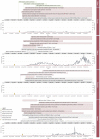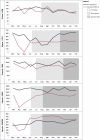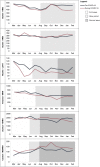A mixed-methods study of maternal health care utilisation in six referral hospitals in four sub-Saharan African countries before and during the COVID-19 pandemic
- PMID: 35173022
- PMCID: PMC8852239
- DOI: 10.1136/bmjgh-2021-008064
A mixed-methods study of maternal health care utilisation in six referral hospitals in four sub-Saharan African countries before and during the COVID-19 pandemic
Abstract
Introduction: In sub-Saharan Africa, referral hospitals are important sources of key maternal health services, especially during a crisis such as the COVID-19 pandemic. This study prospectively assessed the effect of the COVID-19 pandemic on maternal health service utilisation in six large referral hospitals in Guinea, Nigeria, Tanzania and Uganda during the first year of the pandemic.
Methods: Mixed-methods design combining three data sources: (1) quantitative data based on routine antenatal, childbirth and postnatal care data collected March 2019-February 2021, (2) qualitative data from recurring rounds of semi-structured interviews conducted July 2020-February 2021 with 22 maternity skilled heath personnel exploring their perceptions of service utilisation and (3) timeline data of COVID-19 epidemiology, global, national and hospital-level events. Qualitative and quantitative data were analysed separately, framed based on the timeline analysis and triangulated when reporting.
Results: Three periods including a first wave, slow period and second wave were identified. Maternal health service utilisation was lower during the pandemic compared with the prepandemic year in all but one selected referral hospital. During the pandemic, service utilisation was particularly lower during the waves and higher or stable during the slow period. Fear of being infected in hospitals, lack of transportation, and even when available, high cost of transportation and service closures were key reasons affecting utilisation during the waves. However, community perception that the pandemic was over or insinuation by Government of the same appeared to stabilise use of referral hospitals for childbirth.
Conclusion: Utilisation of maternal health services across the continuum of care varied through the different periods and across countries. In crisis situations such as COVID-19, restrictions and service closures need to be implemented with consideration given to alternative options for women to access and use services. Information on measures put in place for safe hospital use should be communicated to women.
Keywords: COVID-19; descriptive study; health services research; maternal health; obstetrics.
© Author(s) (or their employer(s)) 2022. Re-use permitted under CC BY-NC. No commercial re-use. See rights and permissions. Published by BMJ.
Conflict of interest statement
Competing interests: None declared.
Figures




References
-
- World Health Organization . WHO coronavirus disease (COVID-19) dashboard [online], 2020. Available: https://covid19.who.int/ [Accessed 22 Sep 2020].
-
- Africa CDC Dashboard . Coronavirus disease 2019 (COVID-19) latest updated on the COVID-19 crises Africa CDC [online], 2020. Available: africacdc.org/covid-19/ [Accessed 1 Sep 2020].
-
- WHO . Report of the WHO-China joint mission on coronavirus disease 2019 (COVID-19) [online], 2020. Available: https://www.who.int/docs/default-source/coronaviruse/who-china-joint-mis...
Publication types
MeSH terms
LinkOut - more resources
Full Text Sources
Medical
